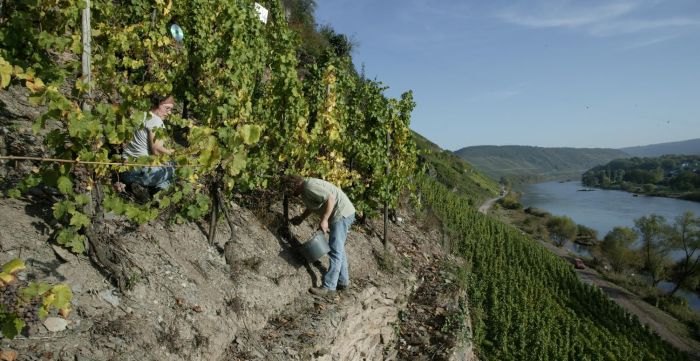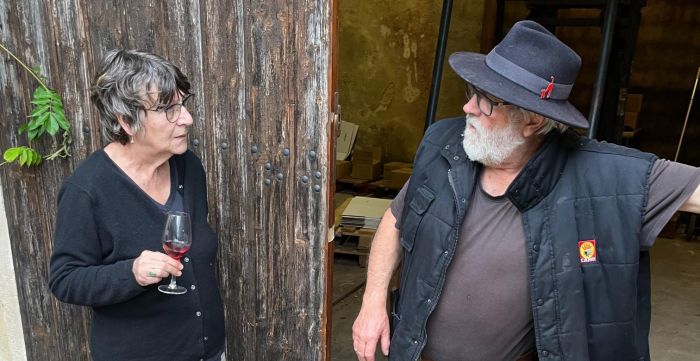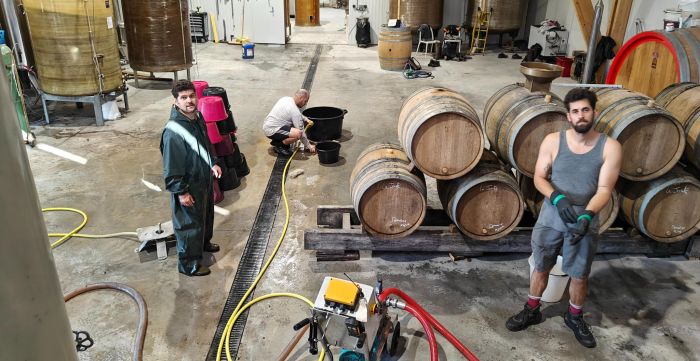Please wait ...

A Remembrance of Sebastiano De Bartoli.

A Remembrance of Sebastiano De Bartoli.
<p><em><strong>by Kevin McKenna</strong></em></p>
<p>After a long and valiant battle against cancer, Sebastiano De Bartoli passed last<br />
week…I’ve a heavy heart. The middle child and second son of the real-life legend Marco de Bartoli, Sebio is the reason we’ve worked with the fascinating and quite often sensational wines of the two estates – the historic Marsala cellar in Contrade Samperi and the Arabic-influenced Bukkuram farm on the island of Pantelleria. While both cellars were founded by his visionary father, Sebastiano along with his brother and sister, Renato and Giuseppina, brought the wineries into the new century with equal commitment to quality and tradition.</p>
<p>A maverick about preserving the tradition of pre-British Marsala wine -- unfortified with perpetual aging in barrels at a naturally high alcohol level – Marco ran up against the law and put fear in the heart of the large and lucrative commercial Marsala producers. As a result, the fraud authorities unjustly shut down the winery for a few years. Finally, he was found to have done nothing wrong, but the closure had taken its toll and the moment arose when for his kids to move forward and for him to step back. </p>
<p>Sebastiano became responsible for the farm on Pantelleria of 6HA (dividing his time between Marsala and Pantelleria) and Renato and Gipi were in Marsala – Renato perfecting the classic method sparkling wine and fighting the authorities to finally accept their Vecchio Samperi as a legitimate regional wine with long history (though they could not label it as Marsala) and Gipi in charge of affairs. But Sebastiano also lobbied his siblings to create a new line of wines that also represented a regional tradition in both Marsala and Pantelleria – skin-contact dry white wines from Grillo (Marsala) and Zibibbo (Pantelleria) – these are the Integer line of wines.</p>
<p>Sebastiano realized that they were heading in a direction that required a change to their distribution – finding partners that were focused on and understood the importance of their work and legacy. A few of the growers with whom we were working at the time also enjoyed a deep friendship and mutual respect with Marco, and, I‘m guessing here, our name came up. Sebio contacted me and we met up at either one of the trade shows like Vini di Vignaioli or maybe it was Vinitaly itself or maybe both. That was the beginning of a rapport that I’ve always treasured and have missed terribly in recent years. It was somewhere around 2010, I think, that I showed up in Marsala and (am forever grateful) to have had some time with Marco himself<br />
and the rest of the family….in the following years Sebastiano and I spent quite a bit of time together.</p>
<p>Sebastiano was not only a vignaiolo, a thinker, a sculptor, a painter, an innovator, a bit of an infamous lothario, a collector of gorgeous vintage Italian cars, oh, and, damn, a really good cook! But also, finally, a son, brother, husband, father. And like his dad a fiercely proud, enthusiastic Sicilian. One time, for instance, he made our group stop for, what he considered, the best cannoli in a dusty, very hot and tiny town about 30 minutes before Marsala on the route from Palermo. He wasn’t wrong. Sebastiano’s many visits to the US whether with our growers on tour, with his sister on her first voyage to the US or in the company of then-fiancé, now-wife, Eleonora or as a part of the team of young “turks” - Arianna, Saša and Luca Roagna - are cherished memories for all of us.</p>
<p>I send all my best condolences to the entire De Bartoli family and especially to Elenora and the children.</p>
<p>Ci brindiamo tutti quanti con tanto affetto e tutto del mio cuore nostro carissimo<br />
collego nella battaglia per i vini di tradizione e anima. Addio, caro Sebastiano.</p>
Article
Tips For Navigating the Website.

How to navigate the website.
<p><u><strong>Desktop vs Mobile:</strong></u></p>
<p>We know people use their phones a lot, so we've worked hard on ensuring the site functions well on mobile devices. Having said that, we recommend using a laptop/desktop to optimally peruse our content. </p>
<p><u><strong>Glossary:</strong></u></p>
<p>At its core, this has always been a website written for wine professionals *attempting* to glean information on the wines we import - and hopefully see a picture of the vigneron's dog. Since the jargon can be so technical, we've added an <glossary term="glossary" title="1427">interactive glossary</glossary> to the text for those unfamiliar with the baffllingly complex world of wine terminology. Even if you're a seasoned pro, you might learn a thing or two. And if you'd rather read the content without the glossary, simply head to the main menu bar and turn it off. </p>
<p> "<u><strong>Our Wines" Section: </strong></u></p>
<p>In the "Our Wines" section, we've offered a variety of filter categories for you to explore and discover all the cuvées we import. These filters can be combined together to narrow down results. If you hit a wall with no results, simply erase one of the filters or clear all filters. </p>
<p><u><strong>Technical Information For Each Wine:</strong></u></p>
<p>78% of the wines we import have extremely detailed technical information when clicked on, dare I say the most technical anywhere on the internet. Half of these are probably woefully outdated.</p>
<p><u><strong>Search:</strong></u></p>
<p>If you know what producer or wine you are searching for, the search should quickly autofill what you need. Go ahead, give it a whirl. You can also hit enter after searching and skup the autofill.</p>
<p><strong><u>Hyperlinks/PDFs:</u></strong></p>
<p>Every single piece of content on the website has its own hyperlink. This means you can easily share a specific producer page, article, wine or filter combination with anyone. You can also save or print out PDF's bt clicking the PDF icon.</p>
<p><u><strong>Copy/Paste:</strong></u></p>
<p>Due to the website's design, if you need to copy/paste anything, the glossary needs to be turned off for the text to paste correctly. We recommend using the PDF feature instead. </p>
<p>Also, if you are going to straight up use our writing verbatim, PLEASE credit us when doing so. Seems obvious but we see it happen all the time. </p>
<p><u><strong>A Shit-Ton of Written Content:</strong></u></p>
<p>The articles themselves can often be very long, and for this reason we developed a Propriety Pop Up System™ where you can easily scroll through various articles/wines and "pop out" to efficiently look at the rest of the content.</p>
<p>We've tried our best to pack as many dog pictures as possible in there, but the digital ink has been spilled: the cumulation of decades' worth of writings from Joe, Denyse, Kevin and Jules is here for you to read. A huge part of the work with this new website was to find better ways to condense and extract essential information you need without getting lost in all that BORING text. </p>
<p>We still think you should check it out. Don't worry, there are plenty of pictures. And you might even find the writing interesting. Or funny. Or both. </p>
Article
EXPLORE

Domaine Chamonard Producer Profile
<p>Domaine Chamonard is a multi-generation family estate run, somewhat unintuitively, by the Chanudet family. At the helm for over 50 years, Jean-Claude "Le Chat" Chanudet has humbly been making "Jules Chauvet" style, semi-carbonically fermented Beaujolais for decades. In fact, Beaujolais lover and good friend Eric Texier considers Chanudet, who is meticulous in his lab analyses of his wines, the closest of anyone to work the way Chauvet intended. </p>
<p>Retired on paper but still a daily presence in the vines and cellar, Jean-Claude recently passed on the estate to his daughter Jeanne, and together they work a total of 5.5 hectares. The vast majority is in the Morgon cru, where they farm seven parcels spread over three major sectors: Grands Cras, Le Colombien and Chateau Gaillard. The rest of the vines are in the Fleurie lieu-dit La Madone: a very steep hill and amongst the most famous in the cru. </p>
<p>While each Morgon parcel is vinified individually, the Chanudet intentionally choose to make a single Morgon each vintage, creating a complex blend of their terroirs. Firm believers in selling this cuvée when it's drinking at its best, they release the wines non-chronologically. For example, they have just recently sold out of the 2021 and just now commercialising the 2020. They also intentionally hold back significant quantities to intentionally age and release them many years later, hence our opportunity to offer you the 2015 vintage. The Fleurie, on the other hand, is bottled as La Madone and, due to the style and limited amounts produced, released chronologically.</p>

2024: A Rainy, Lucky, Reasonably Good Harvest at Domaine Mosse
<p><em><strong>“2022 leaves us with the impression that we've seen what the future holds in terms of climate change: spring frost, lack of rain, summer heat.”</strong></em></p>
<p>I wrote this for the 2022 harvest report. I was so wrong. So either I’m a total fool or the climate is changing and unpredictable. Most likely both.</p>
<p>2024 was super rainy and it still is as I’m writing this on December 11th. It’s been raining for pretty much a year here. So we had to adapt our work in the vineyard, no plowing, just cutting the grass, a lot of spraying against mildew. But at the end we had a reasonably good harvest. And we realize how lucky we were this year compared to a lot of other regions of France.</p>
<p>We hired a large team of young and motivated Europeans so the harvest was fast, finished in 3 weeks which is very comfortable compared to some vintages where it seems to last forever.</p>
<p>Yields and maturity were almost normal. The juices are fermenting very slowly in our brand new cellar but we stay patient. You can expect bright acidity and the whole range to be produced this vintage.</p>
<p><br />
<img src="https://louisdressner.com/uploads/images/article//1032/0e/12/0e12ff6b98efdec1011d6834c05ae356.jpg" /><img src="https://louisdressner.com/uploads/images/article//1032/cf/3a/cf3aee79f086c33bc495ba3287c56de3.jpg" /><img src="https://louisdressner.com/uploads/images/article//1032/be/35/be3578d7b5ffac66dd8d542a5cb457e7.jpg" /><img src="https://louisdressner.com/uploads/images/article//1032/c0/d7/c0d7f956338c8e5da51b69195fcd49cf.jpg" /><img src="https://louisdressner.com/uploads/images/article//1032/8f/dd/8fddb44725e40ab2395a47a330013bc0.jpg" /><img src="https://louisdressner.com/uploads/images/article//1032/bf/65/bf658f58e76e60e1695489d9e6aefdc0.jpg" /><img src="https://louisdressner.com/uploads/images/article//1032/6b/7b/6b7baa8da4ec4be0d6ce88ba22f185fb.jpg" /><img src="https://louisdressner.com/uploads/images/article//1032/da/f5/daf57c52280fcfec91afc9558ee0fac4.jpg" /><img src="https://louisdressner.com/uploads/images/article//1032/fc/34/fc34f11bcac037a1bd5816a947b11280.jpg" /><img src="https://louisdressner.com/uploads/images/article//1032/45/65/4565ecdf462907213c87c53a78b929d3.jpg" /><img src="https://louisdressner.com/uploads/images/article//1032/69/71/6971c0779eb93d0bbacde165e87c4054.jpg" /><img src="https://louisdressner.com/uploads/images/article//1032/91/ed/91ed50c09bed27f5804d2a4049a5b116.jpg" /><img src="https://louisdressner.com/uploads/images/article//1032/8b/c6/8bc6b98a1bdc76bcf33b9cf27cb18b33.jpg" /><img src="https://louisdressner.com/uploads/images/article//1032/6d/91/6d914dd4d3d9c7a5e251f7f2cfe85aa3.jpg" /><img src="https://louisdressner.com/uploads/images/article//1032/dd/9c/dd9cffdcb99760d017de31c48c00b27c.jpg" /><img src="https://louisdressner.com/uploads/images/article//1032/46/b3/46b3f09bb29e4a96490ca0a9552ca303.jpg" /><img src="https://louisdressner.com/uploads/images/article//1032/53/17/5317ec87b8b028c5a3db6d3a34c186eb.jpg" /><img src="https://louisdressner.com/uploads/images/article//1032/ed/92/ed92dc0cd7ea4bd05e1fed9f40a867fa.jpg" /></p>